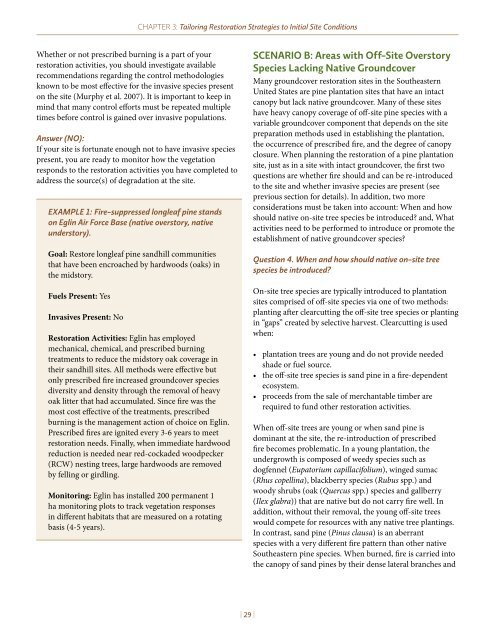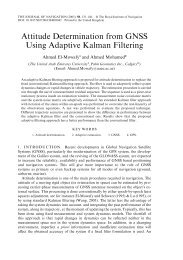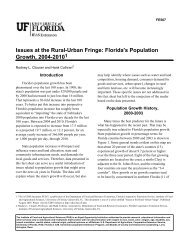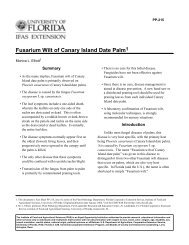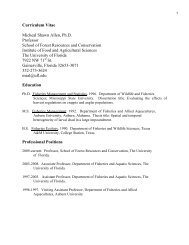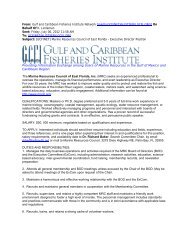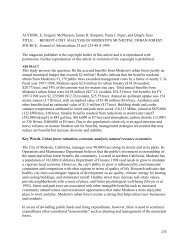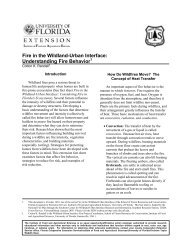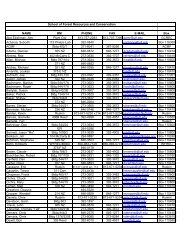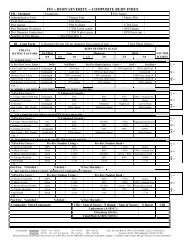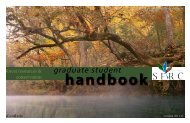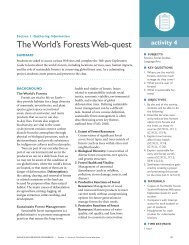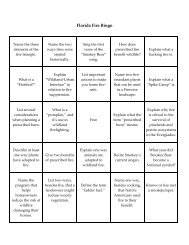Chapter 3: Tailor<strong>in</strong>g <strong>Restoration</strong> Strategies to Initial Site Conditionsand duration <strong>of</strong> smolder<strong>in</strong>g duff fires have been implicated<strong>in</strong> <strong>in</strong>creased native p<strong>in</strong>e mortality (Varner et al. 2005). Iffuel ladders exist, <strong>the</strong>y can be th<strong>in</strong>ned mechanically (e.g.,brush hog or gyro-trac) or herbicides can be applied totop kill shrubs and cause leaf drop. If <strong>the</strong>re is a concernthat deep litter and duff layers could cause unnecessarytree or rare species mortality dur<strong>in</strong>g normal prescribedburn<strong>in</strong>g, two activities can be employed. First, <strong>the</strong> thick duffaround <strong>in</strong>dividual plants can be raked away from <strong>the</strong> roots.Second, <strong>the</strong> first few prescribed burns can be implementeddur<strong>in</strong>g environmental conditions that will ensure a “cool”fire (dormant season or when duff is wet) to remove <strong>the</strong>duff layer <strong>in</strong>crementally. These fires may not be useful<strong>in</strong> top-kill<strong>in</strong>g encroach<strong>in</strong>g shrub species or promot<strong>in</strong>greproduction <strong>in</strong> most herbaceous species, but once <strong>the</strong> dufflayer is reduced, hotter prescribed fires with more completecoverage can be <strong>in</strong>troduced to achieve this objective (Outcalt2006). F<strong>in</strong>ally, recent research has shown that prescribedfire is both an effective and <strong>in</strong>expensive tool for restorationbut that it can take a m<strong>in</strong>imum <strong>of</strong> three prescribed firesbefore groundcover responses reach restoration goals <strong>in</strong> firesuppressedlongleaf sites (K. Outcalt, USFS, pers. comm.).Answer (YES to question 1, NO to question 2):If <strong>the</strong> community to be restored is fire dependentbut adequate f<strong>in</strong>e fuels are not present at <strong>the</strong> site, <strong>the</strong>restorationist must use mechanical or chemical treatments(especially cut-and-treat or basal spray) to remove woodyvegetation <strong>in</strong> <strong>the</strong> midstory and canopy to <strong>in</strong>crease light at<strong>the</strong> forest floor. Some restorationists are able to <strong>in</strong>troducefire once this treated vegetation has aged (dried) but for <strong>the</strong>cont<strong>in</strong>ued application <strong>of</strong> prescribed fire, it is essential thatpopulations <strong>of</strong> native groundcover species that can carry fire(e.g., wiregrass) <strong>in</strong>crease <strong>in</strong> cover on <strong>the</strong> site. If <strong>the</strong> coverage<strong>of</strong> <strong>the</strong>se species does not <strong>in</strong>crease follow<strong>in</strong>g <strong>the</strong> <strong>in</strong>itialth<strong>in</strong>n<strong>in</strong>g and/or burn<strong>in</strong>g treatments, it will be necessary toseed or plant <strong>the</strong>se species on <strong>the</strong> site.Answer (NO to questions 1 and 2):If fire is not a driver (or is extremely <strong>in</strong>frequent) <strong>in</strong> <strong>the</strong>reference community for your site, <strong>the</strong> second most likelycause for degradation is human <strong>in</strong>terference <strong>in</strong> an ecologicalprocess such as hydrology, regeneration (forest productremoval impacts), or dispersal through <strong>the</strong> separation <strong>of</strong> <strong>the</strong>site from <strong>in</strong>tact communities by barriers, roads, or trails.The first two impacts can be addressed immediately. If<strong>the</strong> site is to be restored, any impediments to <strong>the</strong> naturalhydrology must be removed first. In addition, forest productharvest<strong>in</strong>g (plant or seed removal) must be prevented untildata <strong>in</strong>dicate that harvest levels will not affect <strong>the</strong> long-termviability <strong>of</strong> populations on that site.If <strong>the</strong> restoration site is an island <strong>of</strong> remnant vegetation <strong>in</strong>a sea <strong>of</strong> highly degraded habitats, <strong>the</strong> restorationist mustconsider that <strong>the</strong> degradation <strong>of</strong> that habitat may be dueto <strong>the</strong> loss <strong>of</strong> specialized poll<strong>in</strong>ators or seed dispersers oran imbalance <strong>in</strong> herbivores and/or predator populations.Extremely small or isolated restoration sites may not have<strong>the</strong> resources necessary to ma<strong>in</strong>ta<strong>in</strong> populations <strong>of</strong> essentialfauna or ma<strong>in</strong>ta<strong>in</strong> balance <strong>in</strong> <strong>the</strong>ir populations. One <strong>of</strong> <strong>the</strong>unforeseen results <strong>of</strong> habitat fragmentation and urbanizationhas been <strong>the</strong> loss <strong>of</strong> specialized poll<strong>in</strong>ators. When study<strong>in</strong>gseed set and predation <strong>in</strong> urban environments, it has beenfound that seed predation is higher and seed set is lower<strong>in</strong> fragmented habitats (Aizen and Fe<strong>in</strong>s<strong>in</strong>ger 2003). Inaddition, <strong>in</strong> remnant patches <strong>in</strong> an urban matrix, pesticidedrift may be responsible for <strong>the</strong> loss <strong>of</strong> poll<strong>in</strong>ators andreduction <strong>of</strong> <strong>in</strong>sect diversity (Buchmann and Nabhan1996; Heuberger and Putz 2003). Conduct<strong>in</strong>g an <strong>in</strong>ventory<strong>of</strong> organisms responsible for poll<strong>in</strong>ation, seed dispersal,herbivory, and predation at a restoration site may be a usefulmeans <strong>of</strong> identify<strong>in</strong>g necessary modifications <strong>of</strong> fauna.Once <strong>the</strong> role <strong>of</strong> fire has been assessed at <strong>the</strong> restoration site,<strong>the</strong> next major question is:Question 3. Are non-native <strong>in</strong>vasive species present?Answer (YES):If <strong>in</strong>vasive species are present on <strong>the</strong> restoration site and youplan to restore fire to <strong>the</strong> site, it is very important that youdeterm<strong>in</strong>e <strong>the</strong> response <strong>of</strong> <strong>the</strong> <strong>in</strong>vasive species to fire prior toignition. Many <strong>in</strong>vasive species can be reduced or elim<strong>in</strong>atedmechanically or with <strong>the</strong> application <strong>of</strong> selective herbicidesprior to burn<strong>in</strong>g. However, some <strong>in</strong>vasive species respondto fire with copious regeneration, <strong>in</strong>creas<strong>in</strong>g <strong>in</strong> cover afterprescribed burn<strong>in</strong>g (e.g., Zedler and Scheid 1988).Cogongrass is an <strong>in</strong>vasive species that is particularly difficultto control. The species is highly flammable and can change<strong>the</strong> <strong>in</strong>tensity and pattern <strong>of</strong> fire, lead<strong>in</strong>g to <strong>the</strong> reduction<strong>of</strong> native species that normally respond favorably to fire(Lippencott 2000). Treat<strong>in</strong>g cogongrass with herbicidesprior to fire is not recommended, as this can lead to evenmore <strong>in</strong>tense fires. Implement<strong>in</strong>g a cool fire or mow<strong>in</strong>g <strong>the</strong>cogongrass stand before herbicide treatment dur<strong>in</strong>g <strong>the</strong>fall is likely to reduce <strong>the</strong> amount <strong>of</strong> herbicide needed andimprove control <strong>of</strong> <strong>the</strong> species (G. Tanner, University <strong>of</strong>Florida, pers. comm.).| 28 |
Chapter 3: Tailor<strong>in</strong>g <strong>Restoration</strong> Strategies to Initial Site ConditionsWhe<strong>the</strong>r or not prescribed burn<strong>in</strong>g is a part <strong>of</strong> yourrestoration activities, you should <strong>in</strong>vestigate availablerecommendations regard<strong>in</strong>g <strong>the</strong> control methodologiesknown to be most effective for <strong>the</strong> <strong>in</strong>vasive species presenton <strong>the</strong> site (Murphy et al. 2007). It is important to keep <strong>in</strong>m<strong>in</strong>d that many control efforts must be repeated multipletimes before control is ga<strong>in</strong>ed over <strong>in</strong>vasive populations.Answer (NO):If your site is fortunate enough not to have <strong>in</strong>vasive speciespresent, you are ready to monitor how <strong>the</strong> vegetationresponds to <strong>the</strong> restoration activities you have completed toaddress <strong>the</strong> source(s) <strong>of</strong> degradation at <strong>the</strong> site.EXAMPLE 1: Fire-suppressed longleaf p<strong>in</strong>e standson Egl<strong>in</strong> Air Force Base (native overstory, nativeunderstory).Goal: Restore longleaf p<strong>in</strong>e sandhill communitiesthat have been encroached by hardwoods (oaks) <strong>in</strong><strong>the</strong> midstory.Fuels Present: YesInvasives Present: No<strong>Restoration</strong> Activities: Egl<strong>in</strong> has employedmechanical, chemical, and prescribed burn<strong>in</strong>gtreatments to reduce <strong>the</strong> midstory oak coverage <strong>in</strong><strong>the</strong>ir sandhill sites. All methods were effective butonly prescribed fire <strong>in</strong>creased groundcover speciesdiversity and density through <strong>the</strong> removal <strong>of</strong> heavyoak litter that had accumulated. S<strong>in</strong>ce fire was <strong>the</strong>most cost effective <strong>of</strong> <strong>the</strong> treatments, prescribedburn<strong>in</strong>g is <strong>the</strong> management action <strong>of</strong> choice on Egl<strong>in</strong>.Prescribed fires are ignited every 3-6 years to meetrestoration needs. F<strong>in</strong>ally, when immediate hardwoodreduction is needed near red-cockaded woodpecker(RCW) nest<strong>in</strong>g trees, large hardwoods are removedby fell<strong>in</strong>g or girdl<strong>in</strong>g.Monitor<strong>in</strong>g: Egl<strong>in</strong> has <strong>in</strong>stalled 200 permanent 1ha monitor<strong>in</strong>g plots to track vegetation responses<strong>in</strong> different habitats that are measured on a rotat<strong>in</strong>gbasis (4-5 years).Scenario B: Areas with Off-Site OverstorySpecies Lack<strong>in</strong>g Native <strong>Groundcover</strong>Many groundcover restoration sites <strong>in</strong> <strong>the</strong> Sou<strong>the</strong>astern<strong>United</strong> <strong>States</strong> are p<strong>in</strong>e plantation sites that have an <strong>in</strong>tactcanopy but lack native groundcover. Many <strong>of</strong> <strong>the</strong>se siteshave heavy canopy coverage <strong>of</strong> <strong>of</strong>f-site p<strong>in</strong>e species with avariable groundcover component that depends on <strong>the</strong> sitepreparation methods used <strong>in</strong> establish<strong>in</strong>g <strong>the</strong> plantation,<strong>the</strong> occurrence <strong>of</strong> prescribed fire, and <strong>the</strong> degree <strong>of</strong> canopyclosure. When plann<strong>in</strong>g <strong>the</strong> restoration <strong>of</strong> a p<strong>in</strong>e plantationsite, just as <strong>in</strong> a site with <strong>in</strong>tact groundcover, <strong>the</strong> first twoquestions are whe<strong>the</strong>r fire should and can be re-<strong>in</strong>troducedto <strong>the</strong> site and whe<strong>the</strong>r <strong>in</strong>vasive species are present (seeprevious section for details). In addition, two moreconsiderations must be taken <strong>in</strong>to account: When and howshould native on-site tree species be <strong>in</strong>troduced? and, Whatactivities need to be performed to <strong>in</strong>troduce or promote <strong>the</strong>establishment <strong>of</strong> native groundcover species?Question 4. When and how should native on-site treespecies be <strong>in</strong>troduced?On-site tree species are typically <strong>in</strong>troduced to plantationsites comprised <strong>of</strong> <strong>of</strong>f-site species via one <strong>of</strong> two methods:plant<strong>in</strong>g after clearcutt<strong>in</strong>g <strong>the</strong> <strong>of</strong>f-site tree species or plant<strong>in</strong>g<strong>in</strong> “gaps” created by selective harvest. Clearcutt<strong>in</strong>g is usedwhen:• plantation trees are young and do not provide neededshade or fuel source.• <strong>the</strong> <strong>of</strong>f-site tree species is sand p<strong>in</strong>e <strong>in</strong> a fire-dependentecosystem.• proceeds from <strong>the</strong> sale <strong>of</strong> merchantable timber arerequired to fund o<strong>the</strong>r restoration activities.When <strong>of</strong>f-site trees are young or when sand p<strong>in</strong>e isdom<strong>in</strong>ant at <strong>the</strong> site, <strong>the</strong> re-<strong>in</strong>troduction <strong>of</strong> prescribedfire becomes problematic. In a young plantation, <strong>the</strong>undergrowth is composed <strong>of</strong> weedy species such asdogfennel (Eupatorium capillacifolium), w<strong>in</strong>ged sumac(Rhus copell<strong>in</strong>a), blackberry species (Rubus spp.) andwoody shrubs (oak (Quercus spp.) species and gallberry(Ilex glabra)) that are native but do not carry fire well. Inaddition, without <strong>the</strong>ir removal, <strong>the</strong> young <strong>of</strong>f-site treeswould compete for resources with any native tree plant<strong>in</strong>gs.In contrast, sand p<strong>in</strong>e (P<strong>in</strong>us clausa) is an aberrantspecies with a very different fire pattern than o<strong>the</strong>r nativeSou<strong>the</strong>astern p<strong>in</strong>e species. When burned, fire is carried <strong>in</strong>to<strong>the</strong> canopy <strong>of</strong> sand p<strong>in</strong>es by <strong>the</strong>ir dense lateral branches and| 29 |


